The world of fashion is undergoing a radical transformation with the integration of artificial intelligence (AI) into the design, simulation, and experience of clothing. Virtual fashion, powered by AI, is reshaping how consumers interact with clothing brands, try on outfits, and personalize their wardrobe. A fascinating aspect of this technological revolution is the development of AI-powered apps that can simulate undressing and clothing fitting in a virtual space. These applications offer a blend of convenience, innovation, and an enhanced shopping experience, allowing users to visualize how different garments would look on their bodies without ever physically trying them on. In this article, we will explore the future of virtual fashion, particularly the role of AI apps in undressing and clothing simulation, their benefits, challenges, and their potential impact on the fashion industry.
Artificial intelligence has rapidly infiltrated various industries, and fashion is no exception. AI in virtual fashion is not just about creating digital models or avatars. It involves creating highly detailed and realistic simulations of clothing, including textures, colors, and fit, based on a user’s specific measurements. AI allows for advanced body scanning, which means apps can capture the precise contours and dimensions of a user's body to generate virtual clothing that fits perfectly.

These AI-driven tools are evolving to provide more than just virtual fittings. They can create dynamic, interactive experiences where users can simulate undressing, try on various styles, and receive personalized suggestions based on their preferences. AI algorithms can analyze user behavior and trends to offer tailored fashion recommendations, making virtual shopping more intuitive and user-centric. As AI technology continues to advance, the line between the physical and virtual world in fashion becomes increasingly blurred.

AI apps designed for undressing and clothing simulation use sophisticated technologies such as machine learning, computer vision, and augmented reality (AR) to recreate the process of trying on clothes. These apps typically follow these steps:

These steps provide users with an immersive experience that closely mimics real-world shopping, offering a highly personalized and efficient way to try on clothes digitally.
AI-driven virtual fashion apps come with numerous advantages for both consumers and fashion brands. Here are some key benefits:
Despite the promising future of AI in virtual fashion, there are several challenges that need to be addressed:
The future of virtual fashion lies in further integration of AI with emerging technologies such as augmented reality (AR) and virtual reality (VR). As AI becomes more sophisticated, it will be able to create hyper-realistic clothing simulations and even integrate with smart mirrors or AR glasses for real-time, interactive shopping experiences. Additionally, AI can enhance the design process itself, allowing designers to experiment with new ideas and create virtual garments that can be tested before they are made physically.
Looking ahead, AI-powered apps for undressing and clothing simulation will likely become a central feature of the fashion industry. As consumer demand for convenience, personalization, and sustainability grows, fashion brands will need to embrace these technologies to stay competitive. Furthermore, as virtual fashion ecosystems expand, we may see the rise of virtual fashion shows, digital clothing marketplaces, and virtual wardrobes that blur the lines between the digital and physical fashion worlds.
AI apps for undressing and clothing simulation are reshaping the future of fashion, offering consumers an immersive, convenient, and personalized shopping experience. The integration of AI in virtual fashion allows for realistic clothing simulations, helping users make informed purchase decisions without the need for physical try-ons. While challenges such as accuracy, privacy, and accessibility remain, the future of virtual fashion is undeniably promising. As technology continues to evolve, AI-driven fashion tools will become more refined, offering endless possibilities for both consumers and fashion brands. With the potential to revolutionize the industry, virtual fashion powered by AI is set to become a significant part of our digital and physical wardrobes in the years to come.
2024-11-06 00:28
2024-11-05 23:34
2024-11-05 23:13
2024-11-05 22:43
2024-11-05 22:09
2024-11-05 22:06